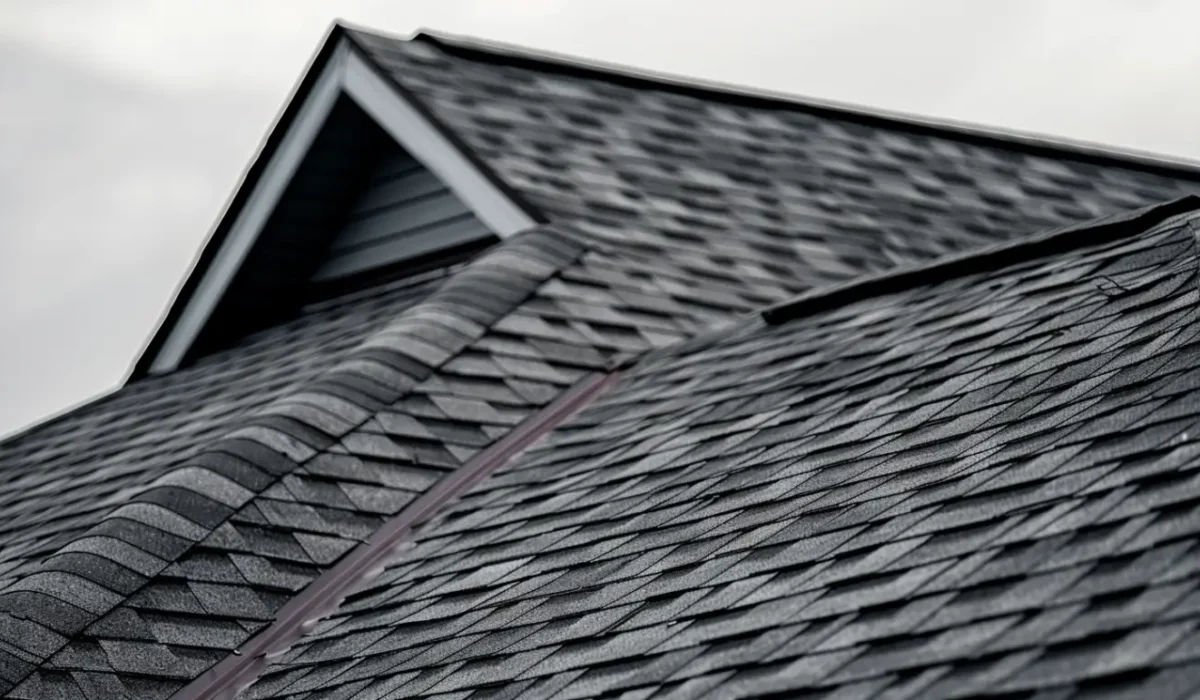Critical to the integrity of any roofing system, roof protects vulnerable areas from water intrusion. At KangaRoof, we understand that this unsung hero directs the flow of water away from roof penetrations, maintaining a watertight seal that prevents costly water damage in Coppell, TX. Our team is dedicated to ensuring that proper installation of flashing is essential, particularly around features like chimneys, skylights, and valleys, where the risk of leaks is heightened. Understanding roof flashing is not just about knowing its types; it also involves recognizing its vital role in safeguarding your home against the elements, a commitment we uphold at KangaRoof.
What Is Roof Flashing and Why Does It Matter?
Roof flashing is a critical barrier designed to direct water away from vulnerable areas of a roof, such as joints and seams. Its importance lies in preventing roof leaks and structural damage, ensuring the longevity and integrity of your home’s roof system.
Contact Us
The Role of Roof Flashing in Protecting Your Home
Safeguarding your home relies heavily on the proper installation of roof flashing, which acts as a barrier against water intrusion. By channeling water away from vulnerable areas like chimneys, vents, and roof valleys, it plays a vital role in maintaining the integrity of your roofing system and the roof surface. Through creating a watertight seal, prevents costly water damage and ensures that your home withstands various weather conditions. Investing in quality material is essential for long-term protection and peace of mind.
How Roof Flashing Prevents Water Leaks and Damage
An effective roofing system hinges on the proper installation of roof flashing, which acts as a barrier against water infiltration. By channeling water away from vulnerable areas such as chimneys, valleys, and roof penetrations, prevents costly water damage. When integrated seamlessly with shingles and roofing materials, a watertight seal is established, safeguarding the structure from water intrusion caused by heavy rainfall or storm damage. Ultimately, this unsung hero plays a vital role in maintaining the integrity of your roof.
Different Types of Roof Flashing Explained
Not all roof works the same way. Your roof has many parts with a lot of angles and spots where it meets other things. There are different types of roof flashing, including wall flashing, which is a specific type of flashing made to protect each area. Knowing about these helps you see why a professional installation is so important. Step flashing goes next to walls, and valley protects where two sides of the roof come together. Every flashing type has its own job. Here are some of the most common kinds of roof flashing and the places they are used on your home.
Step Flashing and Its Uses
Step flashing plays a vital role in protecting roof joints, particularly where shingle courses meet vertical surfaces like walls. Designed to channel water away, this type of consists of overlapping pieces that create a watertight seal, preventing water intrusion and costly water damage. Its strategic installation is essential in vulnerable areas such as chimneys or skylights. For a roofing project, professional installation of step flashing ensures it effectively integrates with the next course of shingles, providing peace of mind against leaks.
Chimney, Valley, and Vent Pipe Flashing—Where Each Goes
Chimney flashing is strategically placed at the intersection of the chimney and the roof plane to prevent water penetration. This piece of creates a watertight seal that guards against moisture intrusion, especially in heavy storms. Valley flashing, on the other hand, is essential in roof valleys where two roof slopes meet, channeling large volumes of water away from vulnerable areas. Lastly, vent pipe encircles plumbing stacks to ensure proper drainage and prevent costly water damage, enhancing the integrity of your roofing system.
Drip Edge and Counter Flashing Functions
Drip edge plays a vital role in directing water away from vulnerable areas where the roof meets the fascia board. This prevents water infiltration and associated costly water damage, ensuring that the roofing system remains effective against adverse weather conditions. On the other hand, counter provides a watertight seal around roof penetrations, such as chimneys and vent pipes, channeling water away from vertical surfaces and safeguarding underlying structures. Integrating these types of flashing is essential for long-lasting roof protection.
Common Materials Used for Roof Flashing
The way roof works depends a lot on what material is used. The best material should last a long time and work well with your roof. It should also match the weather in your area. There are many kinds to choose from, but some are used more in the industry because they work the best. The most used options for roof are galvanized steel, aluminum, and copper. Each type comes with its own price, how long it will last, and how it looks. We will talk more about these choices.
Galvanized Steel Flashing Pros and Cons
Galvanized steel flashing offers a robust solution for diverse roofing applications by providing durability and corrosion resistance. One of its primary advantages lies in its affordability, making it a popular choice among homeowners. However, it can be prone to rust in harsh weather conditions if not properly maintained. Despite this drawback, its strength ensures a watertight seal against water intrusion. Weighing the pros and cons is essential for making informed decisions in any roofing project.
Aluminum, Copper, and Other Flashing Options
Several materials are available, each offering unique benefits and considerations. Aluminum flashing is a popular choice due to its lightweight nature and resistance to rust, making it ideal for various weather conditions. On the other hand, is renowned for its durability and aesthetic appeal, providing a lengthy lifespan if properly maintained. Other alternatives include galvanized steel and vinyl options, suitable for specific applications based on climate and roofing features, ensuring effective water penetration prevention throughout the roofing system.
Keys to Proper Roof Flashing Installation
Picking the right kind and material for your flashing is just part of the job. The main thing is to make sure there is a proper installation. Even the best copper flashing can fail if it is not put in the right way. That is why a professional installation is needed. With a pro, every piece will fit with all other roofing parts, like the roof deck and the shingles. This know-how helps stop gaps, so you get correct layering and a watertight seal. That keeps your home safe for many years.
Integration with Shingles, Underlayment & Roofing Components
Effective integration with shingles and underlayment is crucial for creating a watertight seal and protecting vulnerable areas of the roofing system. Proper installation ensures that each piece of directs water away from critical roof penetrations, such as vent pipes and chimneys, thereby preventing water intrusion and potential costly damage. Experienced roofers understand the importance of aligning flashing with the next course of shingles to maintain the roof’s integrity and enhance its performance against harsh weather conditions.
Small Details That Make a Big Difference
Every piece of flashing, whether it’s step flashing or chimney flashing, plays a vital role in ensuring a watertight seal. For instance, the integration of flashing with the next course of shingles is crucial; improper alignment can lead to water intrusion. Small details, like the placement of drip edge flashing at the roof’s edge or ensuring that materials are weather-resistant, significantly affect the overall functionality of a roofing system, providing long-term peace of mind against costly water damage.
Trust The Experts
The significance of roof flashing cannot be overstated; it serves as the unsung hero of your roofing system. By understanding its vital role, homeowners can appreciate how proper installation and the choice of materials greatly influence the prevention of water infiltration and damage. Neglecting this often-overlooked detail can lead to costly repairs. For protection against water intrusion and the peace of mind it provides, ensuring that all types of flashing are installed correctly is essential for your roofing project. With our certifications, including OC Preferred, Emerald Premium Plus, and GAF Master Elite, you can trust that your roofing needs are in expert hands.
Frequently Asked Questions
What happens if roof flashing is missing or poorly installed?
If roof flashing is missing or improperly installed, water can easily seep into your home, leading to leaks, mold growth, and extensive damage. This oversight compromises your roof’s integrity and increases repair costs over time. Proper installation is crucial for effective protection.
What are flashing details?
Details are critical components in roofing systems that ensure waterproofing around joints, seams, and penetrations. They include specific configurations of material applied to prevent water intrusion, thus safeguarding your home from leaks and structural damage caused by moisture accumulation.
What should flashing look like on a roof?
Flashing on a roof should be installed neatly, with clear, defined edges and aligned properly with roofing materials. It often appears as metal strips that seamlessly transition between different surfaces, ensuring water flows away from critical areas like chimneys, valleys, and vents.
Read our blog: Metal Roofs vs. Shingles: What Works Best in Hail-Prone Areas?
